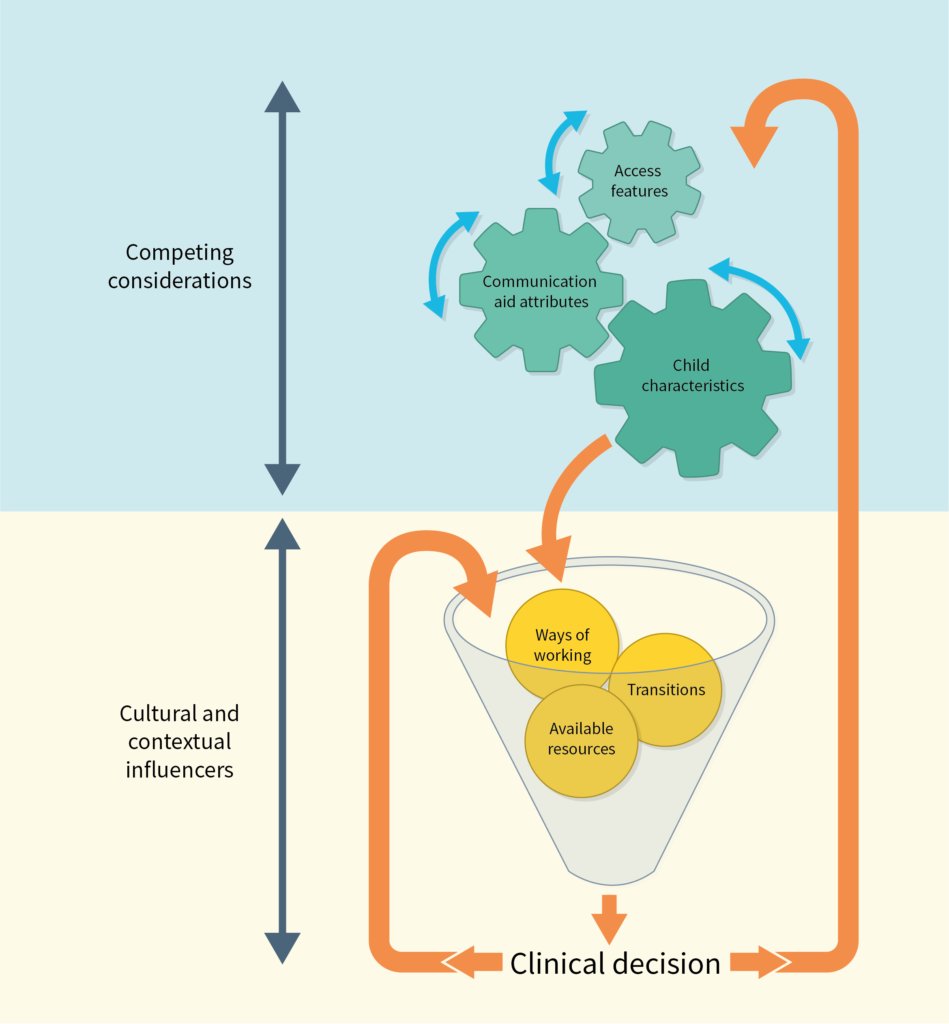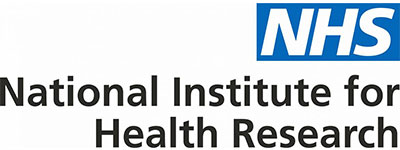About the research
The overall aim of the I-ASC study was to improve the outcomes for children with little or no intelligible speech, who need symbol communication aids to communicate. The specific aim was to provide evidence to influence current practice and to improve the consistency and quality of clinical decision making in the provision of symbol communication aids.

Project overview
The I-ASC (pronounced I ask) project was awarded funding by the NIHR’s Health Services and Delivery Research Programme in January 2016. A ground-breaking and exciting project led by Professor Janice Murray, I-ASC aimed to develop resources to enhance the quality of life for children who need electronic augmentative and alternative communication (AAC).
A collaborative team from Manchester Metropolitan University, the University of Leeds and Barnsley Assistive Technology Service a mixed methods study, to develop new decision making resources to support professionals in health, education and social care, as well as families and other key partners in the decision making process for those who need AAC.
The study investigated four key research questions in order to meet the objectives of the project:
- What attributes related to the child, and generic communication aids, do clinicians consider important in making decisions about communication aid provision?
- What other factors influence or inform the final decision?
- What attributes are considered important by other participants (e.g. the child and family) and how do these impact in the short, medium and long term?
- What decision support guidance and resources would enhance the quality, accountability and comparability of decision making?
There were seven different strands to the study:
The first involved 3 linked systematic reviews to establish current evidence and to inform the next stages of the project. These 3 reviews related to:
- speech, language and communication development with specific reference to children using symbol communication aids;
- the language and communication characteristics the communication aids considered in decision making; and
- clinical decision making related to aided communication in allied health professions.

The second and third strands were qualitative. The second strand involved six focus groups with professionals who were actively involved in AAC assessments to understand their current processes of decision making.
In the third strand, children and young people who use AAC were invited to take part and share their experiences of AAC assessments. A series of 78 interviews were carried out. Fifteen children and young people who use AAC participated. As well as interviewing the children and young people, we also interviewed their family member(s) and the professional team around them to appreciate what the assessment process meant to each of them.
Informed by the first and second strand, the fourth work strand was a quantitative element of the study. This included two surveys that were developed to evaluate clinical decision making processes.
Professionals were asked to make choices between various attributes typically considered in the assessment process and derived from the earlier work strands, to find out which determine their recommendations for prescribing AAC.
These results were combined to produce the fifth component, a decision-making resource (a heuristic) to support professionals and provide those who use AAC and their families with accessible knowledge and information about what to expect from the assessment process. Before being widely disseminated, these resources were tested and evaluated by family and professional AAC experts. This included people who contributed to earlier aspects of the research to test the soundness and reliability of each resource for use in the real world. The content of the decision making resource can be found in the remaining sections of this website.
The sixth strand of the project was all about sharing the research. This element started on day one of the project with awareness raising and it continues beyond the point where the funded project outcomes are achieved through this website, journal publications, and events.
Finally, the study had public involvement (PI) embedded throughout the lifecycle of the study from initial development of the bid, through data collection, analysis, synthesis, and dissemination. The research team was granted an extension to evaluate the co-production aspects of this unique study. This website also includes resources and outputs related to co-producing research with people who use AAC and their families.
Research Team
Chief Investigator
Professor Janice Murray, Professor of Communication Disability and AAC, Faculty of Health, Psychology and Social Care, Manchester Metropolitan University https://www2.mmu.ac.uk/health-psychology-and-communities/our-expertise/communication-disability/ https://www2.mmu.ac.uk/health-psychology-and-communities/staff/
Co-Investigators
Professor Juliet Goldbart, Professor of Developmental Disability, Faculty of Health, Psychology & Social Care, Manchester Metropolitan University https://www2.mmu.ac.uk/health-psychology-and-communities/our-expertise/communication-disability/ https://www2.mmu.ac.uk/health-psychology-and-communities/staff/
Simon Judge, Senior Clinical Scientist, Barnsley Assistive Technology Service, Barnsley Hospital NHS Foundation Trust https://www.barnsleyhospital.nhs.uk/assistive-technology/about/staff/
Professor Stephane Hess, Professor of Choice Modelling, Director of Choice Modelling Centre, University of Leeds https://cmc.leeds.ac.uk/profiles/stephane-hess/
Dr David Meads, Associate Professor in Health Economics, Faculty of Medicine and Health, University of Leeds https://medicinehealth.leeds.ac.uk/medicine/staff/598/dr-david-meads
Research Team
Dr Yvonne Lynch, Research Fellow, Faculty of Health, Psychology and Social Care, Manchester Metropolitan University https://www2.mmu.ac.uk/health-psychology-and-communities/our-expertise/communication-disability/ https://www2.mmu.ac.uk/health-psychology-and-communities/staff/
Stuart Meredith, Co-Researcher (PI), Faculty of Health, Psychology and Social Care, Manchester Metropolitan University
Liz Moulam, Co-Researcher (PI), Faculty of Health, Psychology and Social Care, Manchester Metropolitan University
Dr Mark Jayes, Research Fellow, Faculty of Health, Psychology and Social Care, Manchester Metropolitan University: lead researcher on the Public Involvement evaluation project. https://www2.mmu.ac.uk/health-psychology-and-communities/our-expertise/communication-disability/ https://www2.mmu.ac.uk/health-psychology-and-communities/staff/
Helen Whittle, Research Assistant, Faculty of Health, Psychology and Social Care, Manchester Metropolitan University
Nicola Randall, Research Associate, Barnsley Assistive Technology Service, Barnsley Hospital NHS Foundation Trust https://www.barnsleyhospital.nhs.uk/assistive-technology/about/staff/
Dr Edward Webb, Research Fellow in Health Economics, Faculty of Medicine and Health, University of Leeds https://medicinehealth.leeds.ac.uk/medicine/staff/871/dr-edward-webb
In addition, we had support from a critical friends group and on this there were 3 PI representatives; someone who uses AAC, plus two parents of young adults who use AAC.
The NIHR Advisory Board also appointed a parent of a young adult who uses AAC.
Acknowledgments
Full title: Identifying appropriate symbol communication aids for children who are non-speaking: enhancing clinical decision making (HS&DR number: 14/70/153)
Short title: I-ASC – Identifying Appropriate Symbol Communication
This work has only been possible because of the support, enthusiasm and critical appraisal of many people and organisations. We are grateful for their time, expertise and on-going encouragement. We would like to express our thanks to the following people and organisations.
Funders
The I-ASC project was funded by the National Institute for Health Research Health Services and Delivery Research (NIHR HS&DR) Programme. Throughout the project, we were supported by two NIHR advisors, Samantha Low and Jennifer Cook.
The National Institute for Health Research Health Services and Delivery Research (NIHR HS&DR) Programme was established to fund a broad range of research. It builds on the strengths and contributions of two NIHR research programmes: the Health Services Research (HSR) programme and the Service Delivery and Organisation (SDO) programme, which merged in January 2012. The programme aims to produce rigorous and relevant evidence on the quality, access and organisation of health services, including costs and outcomes. The programme will enhance the strategic focus on research that matters to the NHS. The HS&DR Programme is funded by the NIHR with specific contributions from the CSO in Scotland, NISCHR in Wales and the HSC R&D Division, Public Health Agency in Northern Ireland. www.nets.nihr.ac.uk/programmes/hsdr
The National Institute for Health Research (NIHR) is funded by the Department of Health to improve the health and wealth of the nation through research. Since its establishment in April 2006, the NIHR has transformed research in the NHS. It has increased the volume of applied health research for the benefit of patients and the public, driven faster translation of basic science discoveries into tangible benefits for patients and the economy, and developed and supported the people who conduct and contribute to applied health research. The NIHR plays a key role in the Government’s strategy for economic growth, attracting investment by the life-sciences industries through its world-class infrastructure for health research. Together, the NIHR people, programmes, centres of excellence and systems represent the most integrated health research system in the world. For further information, visit the NIHR website (www.nihr.ac.uk).
Collaborative partners
The content of the I-ASC website is the result of the research conducted by three collaborative partners, Manchester Metropolitan University (lead), Barnsley Assistive Technology service, and the University of Leeds. The core research team were supported by many other colleagues.
Manchester Metropolitan University
Support team: Kelly Lavender-Smith, Zoe Lingard, Zoe Johnston, Christopher Wills, Helen Bell, Gareth Preston, Dr Sue Caton, Christina Sotiropoulou-Drosopoulou, Sam Wright, Radek Loucka, Monwara Begum, Marie Basting, Charlotte Saunders, Chloe Levett-Smith, Sarah Brown, Wanausha Khafaf, Maryam Ahmed, Kerry Wilkins, Natasha Robinson.
Barnsley Assistive Technology Service, Barnsley Hospital Foundation Trust
Support team: Andrea Lee, Gemma Sleman, Beccy Masters.
Participants
This ground-breaking research was only possible because of the responsiveness and support of the many participants involved in different aspects of the I-ASC research project. We, the research team, know who you are and are eternally grateful for your contribution to the research. This resulted in a theoretical framework that resonates across the whole of the UK and a number of resources to support the application of this theoretical framework in clinical decision making. Thank you!
Advisory Board and Critical Friends Group
Thank you to the members of these two groups. They offered wise council, critical appraisal and genuine guidance, resulting in a far more robust outcome to the project.
Specific thanks to Professor Catherine MacKenzie, Jenny Herd, Gregor Gilmour, Professor Martine Smith, Sally Townend, Angie McCormack, Professor Pam Enderby, Professor Luke Vale, Liz Pryde, Nat Mills, and Dr Arne Risehole.
Special contributors
Thanks to Professor Shakila Dada and Associate Professor Beata Batorowicz for their constructive contributions to work strand delivery.
Thanks to Dr Joan Murphy, Talking MatsTM, for her kind support of our data collection techniques.
Thanks to team members from Speech and Language Therapy and Occupational Therapy at the Central Remedial Clinic, Dublin, and specifically Muireann McCleary (Speech and Language Therapy Manager), who supported pilot testing and evaluation during data collection-preparations and provided resource production feedback.
Thanks to Chris Sherlock, Janet Scott, Prof Jois Stansfield, Gregor Gilmour, Ruth McMorran, Jenny Herd, ATTherapy, Gavin Drysdale, Margaret Drysdale, Linda Page, and Judith Chapman for their time in testing and helping us refine resources.
Thanks to Sarah Hannis, Natalie Rowland, Nazifa Khatun, and Gemma Sleman for their artistic support in developing story books to support children and young people to engage in the assessment process.
Thanks to Jon Moulam for his support as photographer at the Scottish Parliament dissemination event.
Thanks to Douglas Millar, Heather Palmer and Jean Alexander who supported organisational aspects of the dissemination event at the Scottish Parliament (Edinburgh). Particular thanks to Fulton MacGregor, MSP for sponsoring the event, Greame Dey, MSP and also to Gavin Drysdale who gave the opening address.
Thanks to Sam Gray for supporting organisational aspects of our dissemination event at MOSI (Manchester), and especial thanks to Carolyn Young, Anna Reeves, Gregor Gilmour, for their contributions to the event.
Thanks to Robert McLaren, Policy Connect, for his support in aiding our delivery of our Westminster dissemination event (London) and in securing sponsors and contributors: The Rt Hon John Bercow, MP, Seema Malhotra, MP, Lord Ramsbotham, Kamini Gadhok, Prof Brian Lamb, Anne Longfield, Marie Gascoigne,Sara Bainbridge,Dr Michael Clarke, Carolyn Young Liz Hewson and Kim Bates.
Particular thanks to Communication Matters and to 1Voice for their support in the recruitment of participants for differing aspects of the project.
Thanks to Professor Bronwyn Helmsley for her support of public involvement (PI) co-created research.
And finally, throughout the life of the I-ASC project we presented at many national and international conferences and study days. At all of these events, we received positive encouragement and constructive feedback. These contributions informed the final website resource. Thank you!






